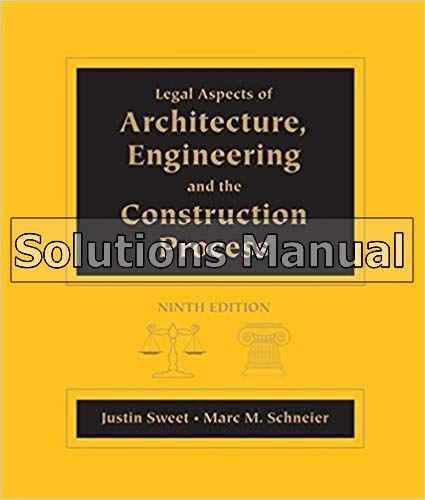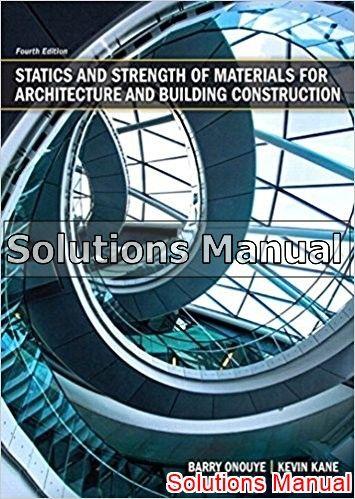Legal Aspects
Architecture Engineering and the Construction Process 9th Edition Sweet Solutions Manual
Go to download the full and correct content document: https://testbankfan.com/product/legal-aspects-of-architecture-engineering-and-the-co nstruction-process-9th-edition-sweet-solutions-manual/

More products digital (pdf, epub, mobi) instant download maybe you interests ...

Construction Law for Design Professionals Construction Managers and Contractors 1st Edition Sweet Solutions Manual
https://testbankfan.com/product/construction-law-for-designprofessionals-construction-managers-and-contractors-1st-editionsweet-solutions-manual/

Managing the Law The Legal Aspects of Doing Business
4th Edition McInnes Solutions Manual
https://testbankfan.com/product/managing-the-law-the-legalaspects-of-doing-business-4th-edition-mcinnes-solutions-manual/

Managing the Law The Legal Aspects of Doing Business
5th Edition McINNes Solutions Manual
https://testbankfan.com/product/managing-the-law-the-legalaspects-of-doing-business-5th-edition-mcinnes-solutions-manual/

Statics and Strength of Materials for Architecture and Building Construction 4th Edition Onouye Solutions Manual
https://testbankfan.com/product/statics-and-strength-ofmaterials-for-architecture-and-building-construction-4th-editiononouye-solutions-manual/

Managing the Law The Legal Aspects of Doing Business
5th Edition McINNes Test Bank
https://testbankfan.com/product/managing-the-law-the-legalaspects-of-doing-business-5th-edition-mcinnes-test-bank/

Managing the Law The Legal Aspects of Doing Business
3rd Edition McInnes Test Bank
https://testbankfan.com/product/managing-the-law-the-legalaspects-of-doing-business-3rd-edition-mcinnes-test-bank/

Managing the Law The Legal Aspects of Doing Business
4th Edition McInnes Test Bank
https://testbankfan.com/product/managing-the-law-the-legalaspects-of-doing-business-4th-edition-mcinnes-test-bank/

Print Reading for Architecture and Construction Technology 3rd Edition Madsen Solutions Manual
https://testbankfan.com/product/print-reading-for-architectureand-construction-technology-3rd-edition-madsen-solutions-manual/

Practical Law of Architecture Engineering and Geoscience Canadian 3rd Edition Samuels Solutions Manual
https://testbankfan.com/product/practical-law-of-architectureengineering-and-geoscience-canadian-3rd-edition-samuelssolutions-manual/
Chapter 9
A number of approaches to this chapter can be useful in the classroom. Discussion can be centered around Section 9.02 with its emphasis upon the more controversial aspects of the licensing process. One way of dealing with this is to take a trade, such as barbering or acting as a beautician, and seek to determine the effect of licensing on that trade. The material for structuring such a discussion is found in Section 9.02. The problem can be put from the vantage point of a group of barbers who wish to give more professionalism to their craft and push for a licensing law or it can be put from the vantage point of a consumer organization who feels there are too many incompetent barbers. In any event the flaws in the licensing process as it is typically constituted in the United States will clearly reveal themselves. If this process has it difficulties for barbers, consider licensing architects or engineers, with the increased difficulty of determining proper levels of competency.
The Duncan case in Section 9.04B should provide for spirited class discussion. Some students are likely to be hard on these engineers while others will think that the sanction was too great in light of much sloppiness generally getting by. The latter students are likely to conclude that the disastrous dimensions of this tragedy were the reasons why these engineers had to take the “hit.”
Another method of approaching the Duncan case is to compare the public aspects of the licensing laws with the private aspects of contracts between owners and design professionals. The court was not willing to allow a private arrangement or custom to frustrate the public policy of the licensing laws.
Section 9.05E includes a new discussion of the responsibility of an architect or engineer who applies the professional seal of another.
Discuss Sections 9.07A and B dealing with sanctions for licensing law violations. The interrelationship of the private law with its emphasis upon the relations between individuals and the public law (penal and licensing sanctions) with its emphasis upon the need of the state to protect its citizens and to regulate certain activities within its confines becomes obvious. As the public law aspects of regulation become more unwieldy and expensive, the public law tries to persuade the private law to help. Some contend that there should be a separation between the two. They would argue that the private law should simply deal with whether a valid contract was made and properly performed. Ask students what would happen if each system is kept separate and the public law aspects of licensing kept out of private law. We doubt this can be done.
Sections 9.07A and B also point to the increasing toughness of licensing laws (see payment reimbursement). But the California cases show that the legislatures want strictness but the courts often refuse to go along.
One way of dealing with the material in Sections 9.06 and 9.07C and D is to call in as a visitor a representative of one of the contractor associations that are likely to be found in the area where the class is being offered. When Professor Sweet has used such individuals, they have been unflagging in their devotion to contractor licensing laws and have emphasized the need for not only having them but for policing them properly. We suspect that these positions are taken to try to professionalize contracting as well as to eliminate competition from fringe contractors. Nevertheless, the material which will follow indicates that contracting has become more complex, and one can ascribe professional characteristics to it, although it is hard to find the usual attributes of a real profession in the business of building structures.
The moonlighting problems in Section 9.08 have good classroom potential. The section resulted from a student paper in Professor Sweet’s seminar — the student’s husband was an architectural student trying to make ends meet doing work while he was going to school. Then ask about the liability problems and the difficulties in collecting for services if the client does not wish to pay for them. These questions are practical ones and ones which can be live ones to the students, many of whom may be facing these problems.
PROBLEMS
1. A was registered as a licensed architect in the state in which she her offices. In that state, licenses must be renewed every five years. Renewals are usually granted unless a large number of complaints have been made with the licensing board. Three month’s before A’s license was required to be renewed, A entered into a written contract for the performance of design services for C. A was paid approximately 60 percent of her fee through interim payments. When the time came for final billing after the services were completed, A realized she had forgotten to renew her registration. She called the licensing board, which informed her that she would have been renewed had she applied at the proper time. A then took steps to renew her registration. However, C discovered that
A had not renewed her registration and now refuses to pay the balance of the fee. She also demands that A return to her the interim fee payments made.
Should A be entitled to recover the balance of the fee? If you conclude she should not, should she be obligated to repay any interim fee payments? Would you like to know any additional facts? If so, what and why?
2. You are a graduate architecture student. You have been asked to design a single-family residence by a developer for whim you wish to work after you become registered. What factors should you take into account? Why would they be relevant?
Can architects employ the substantial compliance doctrine similar to contractors where there has been a technical violation? More can be expected of architects than lesseducated contractors, especially small subcontractors.
Suppose the doctrine is accepted in the case of architects who inadvertently fail to register when they would have easily been able to comply. Is the doctrine a broad one or one which can be used only sparingly in extreme cases? The Latipac case which generated this doctrine had an unusual fact situation. The business manager of the contractor had a mental breakdown and failed to renew the license. In this problem the facts do not indicate more than a simple inadvertence which may not be sufficient to excuse the architect and allow him to assert that he has sufficiently complied to recover for services regulated by the registration laws. Much of the result will depend upon the attitude toward carelessness and the judicial respect or disrespect for the licensing laws. The students should be directed to the Town Planning case in Section 9.07B appears to lean toward separating public and private laws discussed in this Manual. It seems to point toward a solution which is likely to be favorable to the person who has performed properly, although not complying with the licensing or registration laws. Yet Illinois and New Mexico as noted in Section 9.07B point in a different direction. Who is right?
The problem can also be used to point to some of the anomalies in law relating to noncompliance. If a narrow position is taken, that is, that the architect cannot recover, why not allow the client to recover any payments made for services illegally performed? Here, of course, the argument can be made that the law will not and should not interfere with completed transactions. If payment has been made, requiring restoration would frustrate that objective. This can be done only when the illegality is of a serious nature, not one which appears to be involved in this Problem. But look at cases from Illinois and New Mexico and new California legislation.
As to additional facts, was the work properly performed? Did the client benefit from performance by the architect? Why did renewal not occur? The problem simply states that A forgot. While this could have been the only fact that can be developed, other details, such as who had the responsibility for this, whether it had happened in the past, and the reasons for forgetting may be useful in resolving the problem. We might also want to know whether public law sanctions have or are likely to be taken against the architect in such a case. The greater likelihood that they will be taken, the less the private law should be invoked to assist the public law.
2. Some elements of this problem have already been discussed in earlier comments in this chapter. One of the matters which should be taken into account is how much the student needs the money. If so, it is important to determine whether uncovering this moonlighting can bar the architecture student from being registered when he has finished the requirements for registration.
We would also take into account liability problems and whether any judgment would be collectable. Certainly doing work under these conditions increases the likelihood of liability. But if the student has no assets, liability cannot be a serious problem except for moral considerations. But then the law would have to be checked to determine how long a judgment is valid. Even if the student has no money now and does not care about the morality aspects of his being responsible for losses to another, a judgment which is valid for twenty or thirty years, as is sometimes the case, can hurt him at some later date. He
would also check into the problems of insurance. It is quite unlikely that he would be able to obtain any. The principal question then relates to whether he then can obtain exculpation from the client and whether that exculpation will have any effect not only in claims by the client but claims by third parties. Should a client who is willing to take his chances be able to recover from the “moonlighter” if there is a loss? Should he have to pay fees? Are the licensing laws so important that the parties by private arrangement should not be able to bypass them? (Certainly any arrangement of this sort will not affect third parties.)
